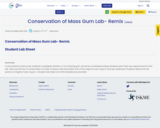
Conditional Remix & Share Permitted
CC BY-NC-SA
In this physical science lab, students investigate whether or not chewing gum should be considered eating. Students plan their own experiments for this lab. They use the law of conservation of mass to reason that the portion lost of the original mass of gum must be swallowed. Students determine the portion of original mass of gum. A student lab sheet and CER template are provided.
- Subject:
- Science
- Material Type:
- Activity/Lab
- Date Added:
- 11/26/2019